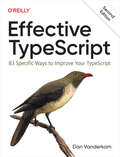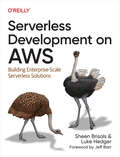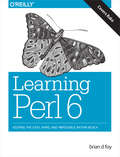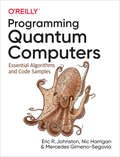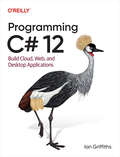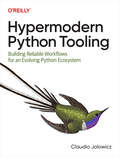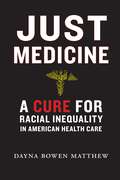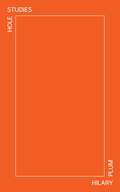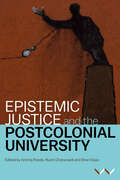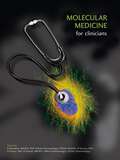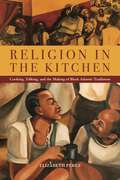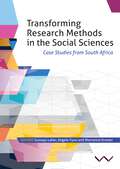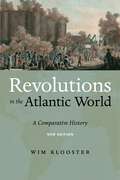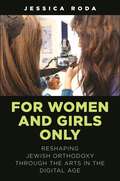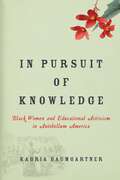- Table View
- List View
Effective TypeScript: 83 Specific Ways to Improve Your TypeScript
by Dan VanderkamTypeScript is a typed superset of JavaScript with the potential to solve many of the headaches for which JavaScript is famous. But TypeScript has a learning curve of its own, and understanding how to use it effectively takes time and practice. Using the format popularized by Effective C++ and Effective Java (both Addison-Wesley), this practical book features 83 items that give specific advice on what to do and what not to do, and how to think about the language. Author Dan Vanderkam shows you how to apply each item's advice through concrete examples. This book will help you advance from a beginning or intermediate user familiar with TypeScript basics to an expert who knows how to use the language well. Updated for TypeScript 5, this second edition includes two new chapters on type-level programming and TypeScript recipes.Learn the nuts and bolts of TypeScript's type systemUse type inference to get full safety with a minimum of type annotationsDesign types to make your code safer and more understandableModel complex APIs using generic types and type-level programmingUnderstand how dependencies and type declaration files work in TypeScriptSuccessfully migrate your JavaScript code base to TypeScript
Serverless Development on AWS: Building Enterprise-Scale Serverless Solutions
by Sheen Brisals Luke HedgerThe adoption of serverless is on the rise, but until now, little guidance has been available for development teams that want to apply this technology on AWS. This definitive guide is packed with architectural, security, and data best practices and patterns for architects and engineers who want to build reliable enterprise-scale serverless solutions.Sheen Brisals, an AWS Serverless Hero, and Luke Hedger, an AWS Community Builder, outline the serverless adoption requirements for an enterprise, examine the development tools your team needs, and explain in depth the nuances of testing event-driven and distributed serverless services. You'll gain practical guidance for keeping up with change and learn how to build serverless solutions with sustainability in mind.Examine the serverless technology ecosystem and AWS services needed to develop serverless applicationsLearn the approach and preparation required for a successful serverless adoption in an enterpriseLearn serverless architectures and implementation patternsDesign, develop, and test distributed serverless microservices on AWS cloudApply security best practices while building serverless solutionsIdentify and adapt the implementation patterns for your particular use caseIncorporate the necessary measures for observable serverless applicationsImplement sustainable serverless applications in the cloud
Learning Perl 6: Keeping the Easy, Hard, and Impossible Within Reach
by Brian D Foyf you’re ready to get started with Raku (formerly Perl 6), this is the book you want, whether you’re a programmer, system administrator, or web hacker. Raku is a new language—a modern reinvention of Perl suitable for almost any task, from short fixes to complete web applications. This hands-on tutorial gets you started.Author brian d foy (Mastering Perl) provides a sophisticated introduction to this new programming language. Each chapter in this guide contains exercises to help you practice what you learn as you learn it. Other books may teach you to program in Raku, but this book will turn you into a Raku programmer.Learn how to work with:Numbers, strings, blocks, and positionalsFiles and directories and input/outputAssociatives, subroutines, classes, and rolesJunctions and setsRegular expressions and built-in grammarsConcurrency features: Promises, supplies, and channelsControlling external programs and other advanced features
Programming Quantum Computers: Essential Algorithms and Code Samples
by Eric R. Johnston Nic Harrigan Mercedes Gimeno-SegoviaQuantum computers are poised to kick-start a new computing revolution—and you can join in right away. If you’re in software engineering, computer graphics, data science, or just an intrigued computerphile, this book provides a hands-on programmer’s guide to understanding quantum computing. Rather than labor through math and theory, you’ll work directly with examples that demonstrate this technology’s unique capabilities.Quantum computing specialists Eric Johnston, Nic Harrigan, and Mercedes Gimeno-Segovia show you how to build the skills, tools, and intuition required to write quantum programs at the center of applications. You’ll understand what quantum computers can do and learn how to identify the types of problems they can solve.This book includes three multichapter sections:Programming for a QPU—Explore core concepts for programming quantum processing units, including how to describe and manipulate qubits and how to perform quantum teleportation.QPU Primitives—Learn algorithmic primitives and techniques, including amplitude amplification, the Quantum Fourier Transform, and phase estimation.QPU Applications—Investigate how QPU primitives are used to build existing applications, including quantum search techniques and Shor’s factoring algorithm.
Programming C# 12: Build Cloud, Web, and Desktop Applications
by Ian GriffithsC# is undeniably one of the most versatile programming languages available to engineers today. With this comprehensive guide, you'll learn just how powerful the combination of C# and .NET can be. Author Ian Griffiths guides you through C# 12.0 and .NET 8 fundamentals and techniques for building cloud, web, and desktop applications.Designed for experienced programmers, this book provides many code examples to help you work with the nuts and bolts of C#, such as generics, LINQ, and asynchronous programming features. You'll get up to speed on .NET 8 and the latest C# 11.0 and 12.0 additions, including generic math, new polymorphism options, enhanced pattern matching, and new features designed to improve productivity.This book helps you:Understand how .NET has changed in recent releases and learn what it means for application developmentSelect the appropriate C# language features for any taskLearn when to use the new features and when to stick with older onesExamine the range of functionality in .NET's class librariesApply these class libraries to practical programming tasksExplore numerous small additions to .NET that improve expressiveness
Hypermodern Python Tooling: Building Reliable Workflows for an Evolving Python Ecosystem
by Claudio JolowiczKeeping up with the Python ecosystem can be daunting. Its developer tooling doesn't provide the out-of-the-box experience native to languages like Rust and Go. When it comes to long-term project maintenance or collaborating with others, every Python project faces the same problem: how to build reliable workflows beyond local development while staying in sync with the evolving ecosystem.With this hands-on guide, Python developers will learn how to forge the moving parts of a Python project into an easy-to-use toolchain, using state-of-the-art tools including Poetry, Nox, pytest, mypy, pre-commit, Black, Ruff, uv, Rye, Hatch, and more. Author Claudio Jolowicz shows you how to create robust Python project structures complete with unit tests, static analysis, code formatting, and type checking.You'll learn how to:Create open source projects with state-of-the-art infrastructureBuild a custom infrastructure for all Python projects in a company or teamImprove and modernize the infrastructure of an existing Python projectEvaluate modern Python tooling for adoption in existing projectsUse tools for packaging and dependency managementAutomate common development tasks such as testing, dependency updates, and publishing releases
Just Medicine: A Cure for Racial Inequality in American Health Care
by Dayna Bowen MatthewOffers an innovative plan to eliminate inequalities in American health care and save the lives they endanger Over 84,000 black and brown lives are needlessly lost each year due to health disparities: the unfair, unjust, and avoidable differences between the quality and quantity of health care provided to Americans who are members of racial and ethnic minorities and care provided to whites. Health disparities have remained stubbornly entrenched in the American health care system—and in Just Medicine Dayna Bowen Matthew finds that they principally arise from unconscious racial and ethnic biases held by physicians, institutional providers, and their patients.Implicit bias is the single most important determinant of health and health care disparities. Because we have missed this fact, the money we spend on training providers to become culturally competent, expanding wellness education programs and community health centers, and even expanding access to health insurance will have only a modest effect on reducing health disparities. We will continue to utterly fail in the effort to eradicate health disparities unless we enact strong, evidence-based legal remedies that accurately address implicit and unintentional forms of discrimination, to replace the weak, tepid, and largely irrelevant legal remedies currently available.Our continued failure to fashion an effective response that purges the effects of implicit bias from American health care, Matthew argues, is unjust and morally untenable. In this book, she unites medical, neuroscience, psychology, and sociology research on implicit bias and health disparities with her own expertise in civil rights and constitutional law. In a time when the health of the entire nation is at risk, it is essential to confront the issues keeping the health care system from providing equal treatment to all.
Hole Studies
by Hilary PlumHole Studies is a book about care and the forms it may take. An essay collection on writing and labor, art and activism, attention as a transformative practice, difference and collaboration, adjuncting and the margins of the academy, whiteness and its weapons, professionalization and its discontents, the radical importance of surprise, friendship at work, the self and its public and private modes: Hole Studies keeps listening. What is it we need from each other? What could we still make happen? This book looks for forms of responsiveness and moments that matter. It honors everyday acts of thinking and trying. Essays explore the music of the Swet Shop Boys, the literature of the US’s brutal war in Iraq, the career of Sinéad O’Connor, the aesthetics of the Dirtbag Left, the legacies of the “war on terror,” feminism on the job, and illness in America. Hole Studies is an intimate document and a critical guide. Hole Studies would like to work for you.
Epistemic Justice and the Postcolonial University
by Athambile Masola Amrita Pande Ruchi Chaturvedi Shari Daya Sepideh Azari Koni Benson Hal Cooper Kerusha Govender Shose Kessi Nomusa Makhubu Lungisile Ntsebeza Jameelah Omar Kealeboga Ramaru Ari Sitas Rike SitasThis book addresses urgent current debates on decolonisation by offering reimagined teaching and learning interventions for obtaining greater epistemic justice in the contemporary postcolonial university.At a time when debates on decolonisation have gained urgency in academic, civic and public spaces, this interdisciplinary collection by authors based at the University of Cape Town, South Africa, serves as a valuable archive documenting and reflecting on a turbulent period in South African higher education. It is an important resource for academics looking to grasp debates on decoloniality both in South Africa, and in university and teaching spaces further afield. Calling for concerted and collaborative work towards greater epistemic justice across diverse disciplines, the book puts forward a new vision of the postcolonial university as one that enables excellent teaching and learning, undertaken in a spirit of critical consciousness and reciprocity.
Molecular Medicine for Clinicians
by B Mendelow, M Ramsay, N Chetty and W StevensThe insights following the wake of the Human Genome project are radically influencing our understanding of the molecular basis of life, health and disease. The improved accuracy and precision of clinical diagnostics is also beginning to have an impact on therapeutics in a fundamental way. This book is suitable for undergraduate medical students, as part of their basic sciences training, but is also relevant to interested under- and postgraduate science and engineering students. It serves as an introductory text for medical registrars in virtually all specialties, and is also of value to the General Practitioner wishing to keep up to date, especially in view of the growing, internet-assisted public knowledge of the field. There is a special focus on the application of molecular medicine in Africa and in developing countries elsewhere.
Religion in the Kitchen: Cooking, Talking, and the Making of Black Atlantic Traditions (North American Religions)
by Elizabeth PérezHonorable Mention, 2019 Barbara T. Christian Literary Award, given by the Caribbean Studies AssociationWinner, 2017 Clifford Geertz Prize in the Anthropology of Religion, presented by the Society for the Anthropology of Religion section of the American Anthropological AssociationFinalist, 2017 Albert J. Raboteau Prize for the Best Book in Africana Religions presented by the Journal of Africana ReligionsAn examination of the religious importance of food among Caribbean and Latin American communitiesBefore honey can be offered to the Afro-Cuban deity Ochún, it must be tasted, to prove to her that it is good. In African-inspired religions throughout the Caribbean, Latin America, and the United States, such gestures instill the attitudes that turn participants into practitioners. Acquiring deep knowledge of the diets of the gods and ancestors constructs adherents’ identities; to learn to fix the gods’ favorite dishes is to be “seasoned” into their service.In this innovative work, Elizabeth Pérez reveals how seemingly trivial "micropractices" such as the preparation of sacred foods, are complex rituals in their own right. Drawing on years of ethnographic research in Chicago among practitioners of Lucumí, the transnational tradition popularly known as Santería, Pérez focuses on the behind-the-scenes work of the primarily women and gay men responsible for feeding the gods. She reveals how cooking and talking around the kitchen table have played vital socializing roles in Black Atlantic religions.Entering the world of divine desires and the varied flavors that speak to them, this volume takes a fresh approach to the anthropology of religion. Its richly textured portrait of a predominantly African-American Lucumí community reconceptualizes race, gender, sexuality, and affect in the formation of religious identity, proposing that every religion coalesces and sustains itself through its own secret recipe of micropractices.
Transforming Research Methods in the Social Sciences: Case Studies from South Africa
by Angelo Flynn Sherianne KramerSocial science researchers in the global South, and in South Africa particularly, utilise research methods in innovative ways in order to respond to contexts characterised by diversity, racial and political tensions, socioeconomic disparities and gender inequalities. These methods often remain undocumented – a gap that this book starts to address. Written by experts from various methodological fields, Transforming Research Methods in the Social Sciences is a comprehensive collation of original essays and cutting-edge research that demonstrates the variety of novel techniques and research methods available to researchers responding to these context-bound issues. It is particularly relevant for study and research in the fields of applied psychology, sociology, ethnography, biography and anthropology. In addition to their unique combination of conceptual and application issues, the chapters also include discussions on ethical considerations relevant to the method in similar global South contexts. Transforming Research Methods in the Social Sciences has much to offer to researchers, professionals and others involved in social science research both locally and internationally.
Elizabeth Cady Stanton and the Feminist Foundations of Family Law
by Tracy A. ThomasThomas Byers Memorial Outstanding Publication Award from the University of Akron Law Alumni AssociationMuch has been written about women’s rights pioneer Elizabeth Cady Stanton. Historians have written her biography, detailed her campaign for woman’s suffrage, documented her partnership with Susan B. Anthony, and compiled all of her extensive writings and papers. Stanton herself was a prolific author; her autobiography, History of Woman Suffrage, and Woman’s Bible are classics. Despite this body of work, scholars and feminists continue to find new and insightful ways to re-examine Stanton and her impact on women’s rights and history. Law scholar Tracy A. Thomas extends this discussion of Stanton’s impact on modern-day feminism by analyzing her intellectual contributions to—and personal experiences with—family law. Stanton’s work on family issues has been overshadowed by her work (especially with Susan B. Anthony) on woman’s suffrage. But throughout her fifty-year career, Stanton emphasized reform of the private sphere of the family as central to achieving women’s equality. By weaving together law, feminist theory, and history, Thomas explores Stanton’s little-examined philosophies on and proposals for women’s equality in marriage, divorce, and family, and reveals that the campaigns for equal gender roles in the family that came to the fore in the 1960s and ’70s had nineteenth-century roots. Using feminist legal theory as a lens to interpret Stanton’s political, legal, and personal work on the family, Thomas argues that Stanton’s positions on divorce, working mothers, domestic violence, childcare, and many other topics were strikingly progressive for her time, providing significant parallels from which to gauge the social and legal policy issues confronting women in marriage and the family today.
Revolutions in the Atlantic World, New Edition: A Comparative History
by Wim KloosterA new look at a contentious period in the history of the Atlantic world Within just a half century, the American, French, Haitian, and Spanish American revolutions transformed the Atlantic world. This book is the first to analyze these events through a comparative lens, revealing several central themes in the field of Atlantic history. From the murky position of the European empire between the Old and New Worlds to slavery and diaspora, Wim Klooster offers insights into the forces behind the many conflicts in the Atlantic world in the late eighteenth and early nineteenth centuries. Digging deeply into the structural causes and oppressive environments in which these revolutions occurred, Klooster debunks the popular myth that the “people” rebelled against a small ruling elite, arguing instead that the revolutions were civil wars in which all classes fought on both sides. The book reveals the extent to which mechanisms of popular mobilization were visible in the revolutions. For example, although Blacks and Indians often played an important role in the success of the revolutions, they were never compensated once new regimes rose to power. Nor was democracy a goal or product of these revolutions, which usually spawned authoritarian polities. The new edition covers the latest historiographical trends in the study of the Atlantic world, including new research regarding the role of privateers. Drawing on fresh research – such as primary documents and extant secondary literature – Klooster ultimately concludes that the Enlightenment was the ideological inspiration for the Age of Revolutions, although not its cause.
For Women and Girls Only: Reshaping Jewish Orthodoxy Through the Arts in the Digital Age
by Jessica RodaWinner of the 2024 Jewish Music Special Interest Group PrizeA compelling look at the lives of ultra-Orthodox and formerly ultra-Orthodox Jewish women and their use of media technologies to create a new market for music and filmMainstream portrayals of ultra-Orthodox religious women often frame their faith as oppressive: they are empowered only when they leave their community. This book flips this notion on its head. Drawing on six years of fieldwork between New York and Montreal, Jessica Roda examines modern performances on the stage and screen directed by and for ultra-Orthodox women. Their incredibly vibrant Jewish artistic scenes defy stereotypes that paint these women as repressed, reclusive to their shtetl (village), and devoid of creativity and agency.For Women and Girls Only argues that access to technology has completely transformed how ultra-Orthodox women express their way of being religious and that the digital era has enabled them to create an alternative entertainment market outside of the public, male-dominated one. Because expectations surrounding modesty, ultra-Orthodox women do not sing, dance, or act in front of men and the public. Yet, in a revolutionary move, they are creating “women and girls only” spaces onsite and online, putting the onus on men to shield themselves from the content. They develop modest public spaces on the Internet, about which male religious leaders are often unaware. The book also explores the entanglement between these observant female artists and those who left religion and became public performers. The author shows that the arts expressed by all these women offer a means of not only social but also economic empowerment in their respective worlds.For Women and Girls Only is a groundbreaking reversal of mainstream portrayals of ultra-Orthodox religious women, and of those who have left the community yet maintain ties to it. It is the first work to focus on the ultra-Orthodox female art scene in music, film, and dance across North America and on social media.
In Pursuit of Knowledge: Black Women and Educational Activism in Antebellum America (Early American Places #5)
by Kabria BaumgartnerWinner, 2021 AERA Outstanding Book AwardWinner, 2021 AERA Division F New Scholar's Book AwardWinner, 2020 Mary Kelley Book Prize, given by the Society for Historians of the Early American RepublicWinner, 2020 Outstanding Book Award, given by the History of Education SocietyUncovers the hidden role of girls and women in the desegregation of American education The story of school desegregation in the United States often begins in the mid-twentieth-century South. Drawing on archival sources and genealogical records, Kabria Baumgartner uncovers the story’s origins in the nineteenth-century Northeast and identifies a previously overlooked group of activists: African American girls and women.In their quest for education, African American girls and women faced numerous obstacles—from threats and harassment to violence. For them, education was a daring undertaking that put them in harm’s way. Yet bold and brave young women such as Sarah Harris, Sarah Parker Remond, Rosetta Morrison, Susan Paul, and Sarah Mapps Douglass persisted. In Pursuit of Knowledge argues that African American girls and women strategized, organized, wrote, and protested for equal school rights—not just for themselves, but for all. Their activism gave rise to a new vision of womanhood: the purposeful woman, who was learned, active, resilient, and forward-thinking. Moreover, these young women set in motion equal-school-rights victories at the local and state level, and laid the groundwork for further action to democratize schools in twentieth-century America. In this thought-provoking book, Baumgartner demonstrates that the confluence of race and gender has shaped the long history of school desegregation in the United States right up to the present.
Advancing Risk Communication with Decision-Makers for Extreme Tropical Cyclones and Other Atypical Climate Events: Proceedings of a Workshop
by Division of Behavioral and Social Sciences and Education Board on Environmental Change and Society Division on Earth and Life Studies Board on Atmospheric Sciences and Climate National Academies of Sciences, Engineering, and MedicineAtypical weather events, such as extreme tropical cyclones, pose substantial threats to life, property and livelihoods in the U.S. and worldwide. Despite major advances in forecasting capabilities, communicating about extreme weather events with decision-makers and the public carries considerable challenges but also provides opportunities for innovation. Decisions surrounding extreme weather events often involve making tradeoffs between different degrees and varieties of risks. For example, deciding whether or when to issue an evacuation order ahead of a tropical cyclone entails tradeoffs between the risks to lives posed by the event and the risks to livelihoods posed by the financial costs of evacuations or relocations. In early 2024, the National Academies held a workshop on risk communication around extreme tropical cyclones and other atypical climate events. Participants aimed to identify opportunities and challenges for risk communication as well as lessons about community engagement and communication concerning other climate events. Over the course of the workshop, participants addressed various facets of risk communication, including the importance and difficulty of clearly communicating uncertainty to the general public; the importance of understanding the needs of various audiences in the context of effective communication; preparedness as a critical component of an effective response; and the often-profound ways that strong partnerships and relationships across sectors and offices can impact and improve risk communication.
Progress Toward Restoring the Everglades: The Tenth Biennial Review—2024
by Water Science and Technology Board Division on Earth and Life Studies Committee on Independent Scientific Review of Everglades Restoration Progress National Academies of Sciences, Engineering, and MedicineThe Florida Everglades is a treasured ecosystem, but the water quality, quantity, flow, and distribution have been dramatically degraded by drainage and infrastructure development during the past century. A joint effort launched by the State and federal government in 2000, the Comprehensive Everglades Restoration Plan (CERP) seeks to reverse the decline of the ecosystem. The National Academies have provided a biennial review of CERP since 2004. This tenth biennial report in the series highlights significant recent restoration progress and offers guidance in three areas: applying Indigenous Knowledge in project planning, using modeling tools for understanding the effects of climate change on the CERP, and strengthening adaptive management for CERP decision making. Thanks to record state and federal investments in recent years, the pace of restoration implementation has reached historic levels and sizeable restoration benefits have been achieved. However, information on natural system restoration progress relative to CERP expectations continues to be difficult to find and interpret. The report recommends modeling tools be applied to anticipate the effects of climate change, including temperature and precipitation, on CERP outcomes and to inform planning and management. Moving forward, consistent and meaningful engagement between CERP agencies and tribal nations is necessary to create a partnership where Indigenous Knowledge can be considered and applied in restoration decision-making. Building expertise and a culture of adaptive management can help ensure continued restoration progress amid uncertainties and improve restoration outcomes through the incorporation of new information.
An Assessment of Selected Research Programs and Goals of the Engineering Laboratory at the National Institute of Standards and Technology: Fiscal Year 2024
by Division on Engineering and Physical Sciences Laboratory Assessments Board National Academies of Sciences, Engineering, and Medicine Panel on Assessment of the National Institute of Standards and Technology (NIST) Engineering LaboratorySince 1959, the National Institute of Standards and Technology (NIST) has engaged the National Academies of Sciences, Engineering, and Medicine annually to assess the quality, effectiveness, and resource adequacy of NIST’s six measurement and standards laboratories. This report reviews the NIST Engineering Laboratory (EL), evaluating technical programs, assessing EL’s portfolio of scientific and technical expertise, reviewing the adequacy of facilities, equipment, and human resources, and evaluating EL’s effectiveness in disseminating its program outputs.
Bridge and Tunnel Strikes: A Guide for Prevention and Mitigation
by Transportation Research Board National Academies of Sciences, Engineering, and Medicine Yang Li Xiao Qin National Cooperative Highway Research Program Neil Janes Hannah Silber Jason J. Bittner Sam Arnold Bob Scopatz Frank Gross Mohammad Wael Amer Andrew Graettinger Habib Tabatabai Dan D’Angelo“Bridge and tunnel strikes inflict serious damage to vehicles, highway bridges, and tunnels; cause injuries and fatalities; and impose detours and costly delays on highway users. Attempts by state departments of transportation (DOTs) and other bridge and tunnel owners to prevent bridge and tunnel strikes include signing, lighting, height detection systems, and actuated warning devices. NCHRP Research Report 1132: Bridge and Tunnel Strikes: A Guide for Prevention and Mitigation, from TRB’s National Cooperative Highway Research Program, presents state-of-the-art information to assist state DOTs in the prevention and mitigation of bridge and tunnel strikes by overheight motor vehicles. Supplemental to the report is NCHRP Web-Only Report 411: Prevention and Mitigation of Bridge and Tunnel Strikes.”
Developing a Guide for Truck Parking Information Management Systems
by Chuck Miller Dan Murray Transportation Research Board National Academies of Sciences, Engineering, and Medicine National Cooperative Highway Research Program Ernie Perry Matt Junak Gui Leao Chris Lindsey Peter RaffertySafe and efficient freight movement depends on sufficient and strategically located truck parking. Federal hours of service regulations require drivers to take breaks at defined intervals, leading to a search for parking ahead of their allowable drive time expires or while staging for their pick-up and delivery slots. This results in lost productivity, higher shipping costs, safety and environmental impacts of circulating trucks, and increased congestion. NCHRP Web-Only Document 415: Developing a Guide for Truck Parking Information Management Systems, from TRB’s National Cooperative Highway Research Program, is supplemental to NCHRP Research Report 1137: Guide for Truck Parking Information Management Systems.
International Talent Programs in the Changing Global Environment
by Policy and Global Affairs National Academies of Sciences, Engineering, and Medicine U.S. Science and Innovation Policy Theme Committee on International Talent Programs in the Changing Global EnvironmentThe U.S. science, technology, engineering, and mathematics (STEM) workforce plays a vital role in fostering and sustaining innovation, economic competitiveness, and national security. This workforce currently depends, and for the foreseeable future will depend, on both international and domestic talent. Foreign STEM talent contributes to domestic innovation, economic growth, and U.S. leadership in science and technology and also expands perspectives and networks essential to future scientific collaborations and discoveries. At the request of the U.S. Department of Defense, this report reviews foreign and domestic talent or incentive programs and their corresponding scientific, economic, and national security benefits. International Talent Programs in the Changing Global Environment makes recommendations to improve the effectiveness of U.S. mechanisms for attracting and retaining international students and scholars relative to the programs and incentives other nations use to support national research capabilities, especially in national security and defense-related fields.
Effects of American Indian Treaties on Development and Operation of Transportation Facilities
by Matthew Adams Transportation Research Board National Academies of Sciences, Engineering, and Medicine Robert Randall National Cooperative Highway Research Program Thomas Sayre William Mumby Nicole Grigg Sara DutschkeTreaties with American Indian tribes played a central role in the development of the United States. While the “treaty era” of federal American Indian policy ended in the 1870s, the treaties themselves, the legal rights they convey, and the tribal governments entitled to exercise those rights all remain important and vital parts of the American legal landscape today. NCHRP Legal Research Digest 94: Effects of American Indian Treaties on Development and Operation of Transportation Facilities, from TRB’s National Cooperative Highway Research Program, notes that treaty obligations cannot be altered, nor reservations diminished, without express congressional authorization. That principle, in turn, raises important questions explored in this digest about planning, development, and operation of transportation infrastructure that crosses lands reserved by treaty.
Incorporating Shock Events into Aviation Demand Forecasting and Airport Planning
by Transportation Research Board National Academies of Sciences, Engineering, and Medicine Airport Cooperative Research Program Christopher Greer Ian KincaidThe COVID-19 pandemic has made clear the vulnerability of aviation and other industries to shock events. While the pandemic is one of the largest events to impact the aviation industry, other previous shock events have also exerted profound impacts on the aviation industry. ACRP Research Report 272: Incorporating Shock Events into Aviation Demand Forecasting and Airport Planning, from TRB’s Airport Cooperative Research Program, provides a methodology to assist airports in identifying and describing relevant shock events, understanding their potential impact on various aspects of the airport business, and developing approaches and strategies to enable the airport to better withstand and respond to shock events if they occur.
Airfield Vehicle Service Road Design and Operations
by Transportation Research Board National Academies of Sciences, Engineering, and Medicine Mark Richter Airport Cooperative Research ProgramIndustry guidance on the planning, operation, and design of airfield vehicle service roads (VSRs) is limited and dispersed across multiple documents. For that reason, VSR systems vary across the industry and are usually influenced by an airport’s unique operational demands, vehicle types, airfield and facility configurations, and other airport-specific characteristics. ACRP Synthesis 139: Airfield Vehicle Service Road Design and Operations, from TRB’s Airport Cooperative Research Program, describes planning, design, and operations for airfield VSR systems, including operations on apron, non-movement, and movement areas. The synthesis considers VSR issues such as maintaining the road, driver’s training, safety concerns, and operational challenges of VSR layouts.
